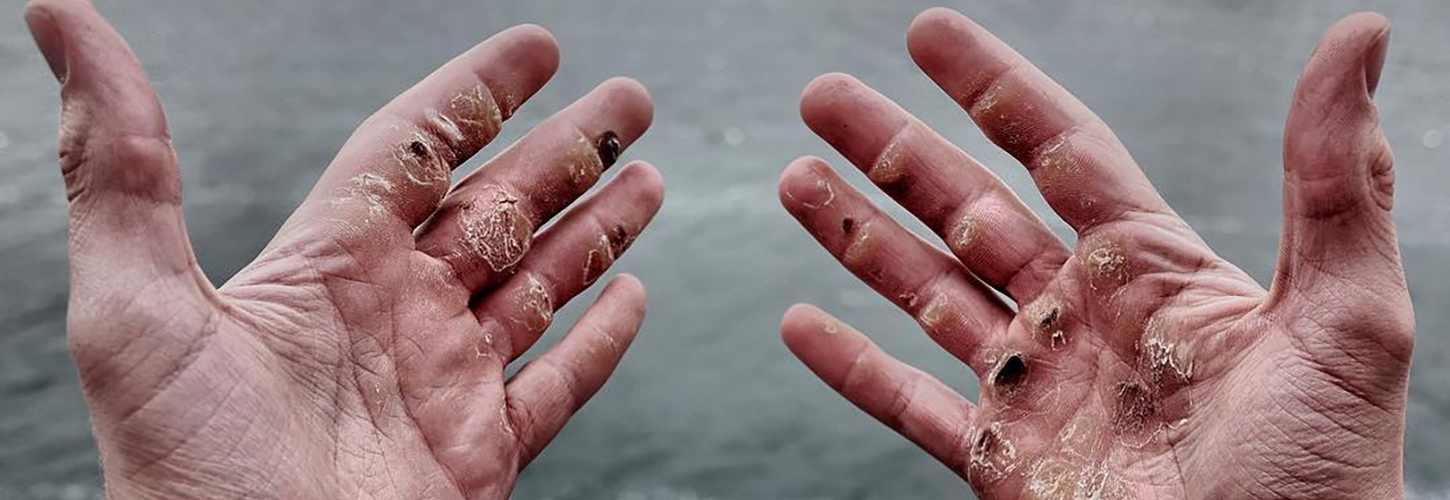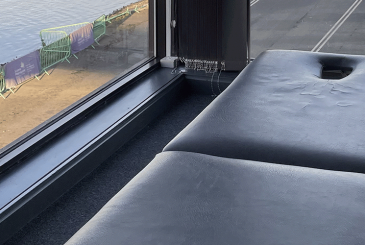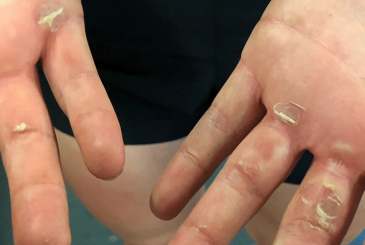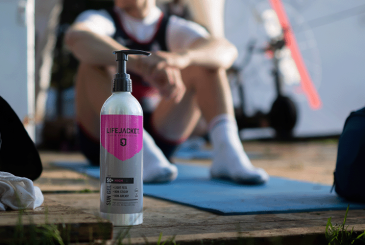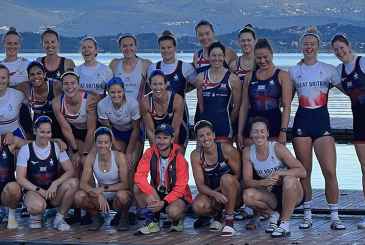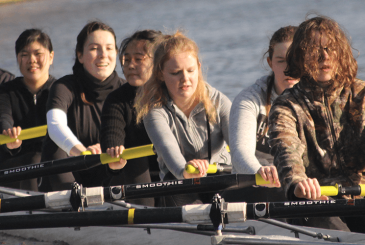Physiotherapist Sally Brown explains why rowers get blisters and what we can do to avoid them
The main causes for skin breakdown in any sport are due to three consistent factors.
- The microclimate of the skin i.e. sweat, wetness and hygiene of the skin
- Friction and shear
- The deformation of tissue under pressure or load.
All these are influenced by the amount of movement at the interface and the duration of exposure.
Why do rowers get blisters?
Many rowers will have experienced skin breakdown at some point, with the most common sites presenting on the hands and buttocks.
In rowing there is almost the perfect storm; the rowing environment is often wet and an average outing totals over 1,500 movement cycles. At the hand, the grip on the oar creates pressure through the skin and during the stroke the hand translates over the handle to create a dynamic friction grip. At the buttocks, body weight pushes into the seat causing pressure over bony prominences, the rockover then creates shear at this interface.
How to avoid and reduce rowing blisters
Optimising skin health can allow athletes to train and compete to the best of their ability without interruptions. Poor skin management can lead to absence due to infection and pain or due to the knock-on effect of compensation movements that lead to a new sudden loading of the musculoskeletal system, increasing the threat of injury.
This article focuses on six things rowers can do to help prevent skin break down by increasing the tolerance of the skin.
1: Be aware of callus and its function
Callus is extended areas of hard, thickened skin and occurs in rowing due to repetition of load. Callus is formed by the body conditioning to help withstand repetitive pressure in a protective response. The function of callus is to provide abrasive resistance and not an enhanced resistance to shear. Callus is localised and connected to less strong tissue, these differences in skin biomechanics create an interface where breakdown can occur either due to shear or an enhanced microclimate conditions such as extreme humidity and sweat increase.
Some callus formation is good and protective. However, the biomechanics of our skin tissue cannot be changed and individuals’ ability to form callus depends on their skin type. The amount of ‘good’ callus will be different for each individual. The surface of the hand constantly changes and athletes need to have the skills to react to how the hand is presenting and have an awareness of their skin state.
Practical tip: As a start point, file down callus by 50%. If the callus is a square ridge, try cutting away the edges to avoid build-up that could be prone to catching and tearing surrounding connective tissue, using a tool like a cuticle cuter can be useful. Use a foot file or appropriate grade sandpaper when your skin has been softened, for example after taking a bath. Follow up by using an emollient (a moisturising product applied directly to the skin to soothe and hydrate it) daily or overnight to create the correct balance. The amount and type of emollient used and the timing of application depends on the dryness of the skin (this is discussed in the next section). This will leave you with supple skin that has protective callus bespoke to where the you need it.
2: Improve your skin’s barrier function
Emollients help to hydrate the skin by sealing the skin barrier to reduce ‘trans epidermal water loss’ (TEWL). Applying them to bony prominences also helps to improve the resilience of the skin in areas most likely to be exposed to impact.
Emollients are available as creams, lotions, and gels. They can also be used as a soap substitute to minimise the potential drying effects from excessive washing and to aid skin conditioning. Although they don’t foam, they are just as effective at cleaning the skin as soap1. (Please refer to the end section for advice on hand hygiene during the COVID pandemic.)
Be aware that typical ‘moisturisers’ often work by acting as humectants (hygroscopic chemicals attracting water) or by providing an artificial barrier to reduce trans epidermal water loss2.
A key requirement in the sports performance context, aside from conditioning the skin by retaining moisture, is the need to minimise skin damage due to friction between the skin surface and the interface with sports equipment. Certain emollients can effectively support skin barrier function (by reducing TEWL and improve hydration) and have potential to reduce the degree of friction at the skin surface, when exposed to impact with sport surfaces or equipment. That said, while this may work well for bone prominences on the buttocks, it may not be practical to reduce friction on the hands as you would be able to maintain an effective grip on the handle through the rowing stroke.
Petroleum jelly, albeit much greasier, also effectively supports the skin barrier function and has the potential to reduce the degree of friction at the skin surface when exposed to impact with sport surfaces or equipment.
Whatever product you use, if the impact forces are too high, it may be impossible to avoid skin laceration. Therefore there is always the need for a long-term commitment to a skin conditioning strategy.
Please note all products are contra-indicated when the skin is infected.
3. Understand the microclimate
Sweat production in peripheral extremities (e.g. hands and feet) is around 10% of total body sweat production. Additionally, glabrous surfaces (skin without hair) e.g. palms of hands or soles of feet, tend to be independent of body thermoregulation.
4. Optimise handles and seats
Ensure an optimal diameter and material of the oar handle for the most relaxed, comfortable grip. The most suitable material may vary depending on climate with some helping to optimise sweat management.
Different seat types or seat pads exists that can help to distribute pressure more evenly through the buttocks. Regularly clean all equipment to promote hygiene and help prevent infections.
5. Keep your skin clean
Shower as soon as possible after training. Use warm water for washing and avoid hot water because it tends to remove sebum – a natural emollient3 – from the skin. Water helps to remove organic debris, skin scales and some pollutants. Effective rinsing after washing helps to remove chemical residues and organic debris.
Sebum is a natural, superior emollient produced by the sebaceous glands and helps to hydrate the skin and maintain its suppleness. Soap is an emulsifier and so will remove sebum3. The alkaline PH of soap can also have a negative effect on the protective chemical environment created by microbiological activity and affect the serine protease activity that increase dryness4.
You can wash your hands and buttocks using an emollient. (Again, please refer to the end section for advice on hand hygiene during the COVID pandemic.)
6. Keep your skin dry
Always dry your skin carefully after washing. Moisture on the skin can promote bacterial and fungal growth and colonisation. Drying techniques will minimise the moisture level and potentially microbial growth. Mainly patting dry with limited rubbing the skin dry helps to remove organic debris and minimises damage to the skin barrier. Excessive rubbing can have an exfoliative effect and so potentially cause irritation and inflammation.
References
1. Emollients Factsheet, National Eczema Society (downloaded 21 September 2022).
2. PENZER, R. and ERSSER. S. Principles of Skin Care: a guide for nurses and other health care professionals. Oxford: Wiley-Blackwell, 2010.
3. ZLOTOGORSKI, A. Distribution of skin surface pH on the forehead and cheek of adults. Archives of Dermatological Research, 1987, 279(6), pp.398- 401.
4. MADISON, K.C. Barrier function of the skin: “La Raison d’Être” of the epidermis. Journal of Investigative Dermatology, 2003, 121(2), pp.231-241.
Photo © Pete Reed.


